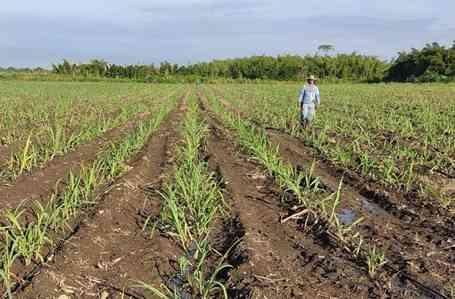Monoculture is a foundational element of today’s intensive farming practices that society depends upon to meet modern food, fuel, and fiber demands. Monoculture, the practice of cultivating a single crop across hundreds or thousands of acres, was borne out of the 1960's Green Revolution, which included a series of successful initiatives to increase agricultural production throughout the world. Other strategies that accompanied the Green Revolution included the development of synthetic fertilizers and pesticides, breeding high-yielding crop varieties, and farm equipment mechanization (Anderson et al., 2017). These advances not only dramatically increased per-acre production; they also increased the average number of acres per farm by over 100% since the 1980s (DePillis, 2013). Despite the indisputable success of the Green Revolution, and monoculture in particular, this agriculture production model has resulted in significant impacts on the insect biodiversity of managed agricultural landscapes. Here, I outline some of the challenges of maintaining insect biodiversity in monocultures and discuss some of the management strategies that have been proven to address some of these challenges.
Why insect biodiversity matters. Insects comprise over 80% of all known terrestrial species and play a critical role in sustaining and supporting life as we know it. Insects are primary decomposers of organic material, provide essential pollination services for natural landscapes and crop production, and add ecosystem balance to complex food webs. For countless reptile, amphibian and bird species, insects make up an essential part of their diet, and could not survive without them. Further, diverse insect communities keep each other in check by preying upon or parasitizing each other, which can suppress insect pest populations. There is no question that without the maintenance diverse and abundant insect populations, the stability of our species and planet would be at risk.
The chemical treadmill. Vast monocultures can alter the equilibrium of natural ecosystems through landscape simplification. In unmanaged, natural landscapes, a diversity of different plants grow and work together in concert to support healthy soils and complex insect communities. When only a single plant is grown and maintained in the landscape, soil health is challenged, and the dietary, refuge, overwintering and reproductive needs of diverse insect species can no longer be met. This makes agricultural crops more vulnerable to insect pests, since the local habitat can no longer support balanced insect communities.

Consequently, farmers apply more pesticides in an attempt to manage pest outbreaks, which can increase the potential for insecticide resistance to develop. When populations of insect pests grow increasingly resistant to pesticide applications, the rate of pesticide application also increases – driving a cycle of growing reliance on chemical applications in managed systems. Additionally, excessive use of fertilizers also contributes to the increase in insect populations by enhancing plant growth and vigor as well as the nutritional qualities of plant tissue that insects feed upon (Lu et al., 2007).
Changing climates = changing insect communities. The challenges of pest management in monoculture systems are compounded by a changing climate. Warmer temperatures have been demonstrated to increase the fecundity and metabolism of insect pests, resulting in elevated pest pressure in cropping systems, which increases insecticide applications (Deutsch et al., 2018).
Increasing temperatures can also extend the geographical distribution of many insect pests northwards and into higher altitudes (Liebhold & Bentz, 2011). Finally, milder winters are likely to increase the survival of overwintering pests since they will be exposed to fewer frosts or cold snaps during that time.
While it may be difficult to prevent or reverse the effects on climate change on modern agriculture, there are some practices that growers may adopt to mitigate some of the unique challenges it presents. This includes adopting more efficient irrigation practices, diversifying crop rotations, and changing management and infrastructure to suit new and expected conditions (Janowiak et al., 2016).
Insects provide benefits. Insect-mediated pollination is an essential component of most cultivated crops and over 80% of all wild, flowering plant species. Pollinators, including bees, butterflies, and even some flies and beetles, require a variety of nectar, pollen, and nesting resources to survive. When monocultures serve as the dominant landscape across swathes of the United States, it prevents pollinators from accessing the diversity and duration of bloom that most pollinators need to thrive.
In addition, insects can boost crop production through the natural biological control of pests by insect predators and parasitoids. However, in simplified landscapes, many predators and parasitoids lack the right conditions (such as places to hide, mate, or spend the winter) to survive over many generations.
We can provide improved support for insect pollinator, predators and parasitoids by planting or maintaining natural and semi-natural habitats, such as forests and meadows, along managed field margins, or by planting diverse floral resources between rows in agricultural production systems.
What to do?
No one can deny that increasing crop yields is vital to having sufficient and affordable food available to feed an increasing human population; nevertheless, it must be recognized that current practices may not be supportive or sustainable in the years to come.
Government subsidies or regulation can be one way to encourage the transformation of monocultures into more sustainable farming systems that are rich in crop diversity and stabilize ecological systems. However, without such support, there are many effective and low-input practices that can be considered. Introducing crop rotation in perennial cover crops, interchanging chemical-based insecticides with organic products, implementing precision agriculture approaches to spot-treat specific crop zones that need fertilizers and pesticide applications as needed, and planting mixture of wild plants in borders or streps to provide resources for beneficial insects are some of the practices that farmers can implement on their farms to improve the ecosystem balance of their crops.
Source : psu.edu